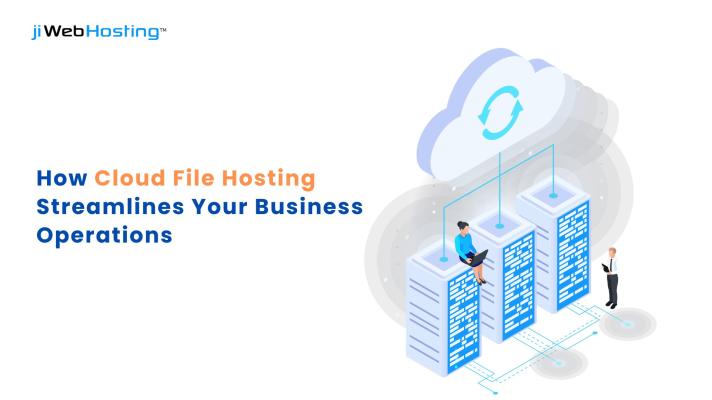- Sep 02, 2025
- 2365
Share this post on:

In the modern digital landscape, the way we store, access, and share files has undergone a profound transformation. Gone are the days when physical storage devices, such as USB drives, external hard drives, or local servers, were the primary means of storing and managing data. Today, cloud file hosting has become the cornerstone of efficient, scalable, and secure file management for individuals, businesses, and enterprises worldwide.
This comprehensive guide will take you through everything you need to know about cloud file hosting, from its fundamental concepts and benefits to practical considerations, security best practices, and future trends. Whether you are a tech enthusiast, a business owner, or someone simply curious about how cloud storage works, this blog will equip you with a thorough understanding to make informed decisions.
What is Cloud File Hosting?
Cloud file hosting refers to the practice of storing files on remote servers that are accessible via the internet, rather than on local physical devices. These servers are maintained by cloud service providers who ensure the infrastructure is secure, reliable, and scalable. When you upload a file to a cloud file hosting service, it is saved on these remote servers and can be accessed anytime, anywhere, as long as you have an internet connection.
Unlike traditional storage methods, cloud file hosting allows users to:
- Access files from multiple devices (computers, smartphones, tablets).
- Share files easily with others without needing physical transfers.
- Collaborate in real-time on documents and projects.
- Scale storage space dynamically based on needs without investing in hardware.
Cloud file hosting is part of the broader category of cloud computing services and is often integrated with other cloud-based tools such as productivity suites, email, and backup solutions.
How Does Cloud File Hosting Work?
At a high level, cloud file hosting works by storing data on a network of servers located in data centers worldwide. Here is a simplified breakdown of the process:
- Uploading Files: When you upload a file, it is sent over the internet to the cloud provider’s servers. The file is typically encrypted during transmission to protect it from interception.
- Storage and Replication: The file is stored on one or more servers. To ensure durability and availability, cloud providers replicate your data across multiple physical locations. This means even if one server or data center experiences an outage, your files remain accessible.
- Metadata Management: Along with the file itself, metadata such as file name, size, creation date, and access permissions are stored. This metadata helps in organizing, searching, and managing files efficiently.
- Access and Synchronization: When you access your files, the cloud service retrieves the data and decrypts it for your use. Many services also synchronize files across devices, meaning if you edit a file on your laptop, the changes automatically reflect on your phone or tablet.
- Sharing and Collaboration: Cloud file hosting platforms offer features that allow you to share files or folders with others. Permissions can be set to control whether recipients can view, comment on, or edit the files.
- APIs and Integrations: Many cloud file hosting services provide APIs that developers can use to integrate storage capabilities into other applications, enabling automated workflows and custom solutions.
Types of Cloud Storage in File Hosting
Understanding the types of cloud storage is essential to grasp how cloud file hosting operates and which solution fits your needs best. There are three primary types:
Object Storage
Object storage manages data as discrete units called "objects," each containing the data itself, metadata, and a unique identifier. This model is ideal for unstructured data such as photos, videos, backups, and archives. Object storage is highly scalable and cost-effective, making it popular for large-scale storage needs. Amazon S3 and Google Cloud Storage are prime examples.
File Storage
File storage provides a traditional hierarchical file system with directories and subdirectories, accessible via standard protocols like SMB (Server Message Block) or NFS (Network File System). This type is best suited for applications that require shared access to files, such as collaborative work environments or legacy applications.
Block Storage
Block storage breaks data into fixed-size blocks and stores them separately. It is typically used for databases, virtual machines, or applications that require high-performance storage with low latency. Block storage is less common for general file hosting but is crucial for performance-sensitive workloads.
Most cloud file hosting services use a combination of these storage types depending on their target audience and use cases.
Benefits of Cloud File Hosting
Cloud file hosting offers numerous advantages over traditional storage methods. Let’s explore the key benefits in detail:
1. Scalability and Flexibility
One of the most significant advantages of cloud file hosting is its ability to scale storage capacity on demand. Whether you need a few gigabytes for personal use or petabytes for enterprise data, cloud storage can accommodate your requirements without the need for physical hardware upgrades. This flexibility allows businesses to grow without worrying about outgrowing their storage infrastructure.
2. Cost Efficiency
Cloud file hosting eliminates the need for upfront capital expenditure on storage hardware. Instead, it operates on a pay-as-you-go model where you pay only for the storage and bandwidth you use. This operational expenditure model helps organizations optimize costs and avoid over-provisioning.
3. Accessibility and Collaboration
Files stored in the cloud can be accessed from anywhere with an internet connection, using any device. This universal accessibility supports remote work, global teams, and flexible workflows. Many cloud file hosting platforms also offer real-time collaboration tools, enabling multiple users to work on the same document simultaneously without version conflicts.
4. Enhanced Security
Leading cloud providers invest heavily in security measures to protect your data. This includes encryption of data in transit and at rest, multi-factor authentication, intrusion detection systems, and regular security audits. Additionally, many providers comply with industry standards and regulations such as GDPR, HIPAA, and ISO 27001, ensuring that your data is handled according to strict privacy and security guidelines.
5. Data Redundancy and Disaster Recovery
Cloud file hosting services replicate data across multiple geographic locations, providing high availability and fault tolerance. In case of hardware failure, natural disasters, or cyberattacks, your data remains safe and accessible. This redundancy simplifies disaster recovery planning and minimizes downtime.
6. Reduced IT Burden
By outsourcing storage infrastructure management to cloud providers, organizations can reduce the operational burden on their IT teams. Providers handle hardware maintenance, software updates, and security patches, freeing internal resources to focus on strategic initiatives.
Popular Cloud File Hosting Services
The market is rich with cloud file hosting options tailored to different needs. Here’s an overview of some of the most popular providers and what they offer:
Google Drive
Google Drive is widely used for personal and business purposes. It integrates seamlessly with Google Workspace (Docs, Sheets, Slides), making it easy to create, store, and collaborate on documents. Google Drive offers generous free storage and affordable paid plans, along with strong security features.
Dropbox
Dropbox is known for its intuitive interface and robust file synchronization capabilities. It supports file versioning, offline access, and team collaboration features. Dropbox Business includes advanced security controls and administrative tools, making it suitable for organizations of all sizes.
Microsoft OneDrive
OneDrive is deeply integrated with Microsoft 365, providing real-time collaboration on Office documents. It offers seamless syncing across devices and strong enterprise-grade security. OneDrive is ideal for businesses invested in the Microsoft ecosystem.
Amazon S3
Amazon Simple Storage Service (S3) is a highly scalable object storage service favored by developers and enterprises. It offers extensive APIs, fine-grained access controls, and integration with other AWS services. Amazon S3 is suitable for large-scale storage, backups, and application data hosting.
Box
Box focuses on enterprise-grade security and compliance, offering advanced workflow automation and content management features. It is popular among regulated industries such as healthcare, finance, and the legal sector.
How to Choose the Right Cloud File Hosting Service
Selecting the right cloud file hosting service depends on your unique requirements. Here are key factors to consider:
Storage Needs
Estimate your current and future storage requirements. Consider whether you need to store large media files, documents, backups, or application data. Choose a provider that offers flexible plans to accommodate growth.
Security and Compliance
Assess the security features offered by the provider, including encryption standards, access controls, and compliance certifications. If you handle sensitive or regulated data, ensure the provider meets relevant legal requirements.
Accessibility and Collaboration
If your team collaborates frequently, look for features like real-time editing, file sharing controls, and integration with productivity tools. Ease of access across devices is also important.
Cost Structure
Understand the pricing model, including storage fees, data transfer costs, and any additional charges for features like versioning or advanced security. Compare plans to find the best value for your budget.
Reliability and Support
Check the provider’s uptime guarantees and support options. Reliable customer support and robust SLAs are critical for business continuity.
Integration and APIs
If you plan to integrate cloud storage with other applications or workflows, evaluate the provider’s API capabilities and compatibility with your existing systems.
Best Practices for Cloud File Hosting
To maximize the benefits and minimize risks, follow these best practices:
Implement Strong Access Controls
Use role-based access permissions and multi-factor authentication to restrict file access. Regularly review user permissions and revoke access for former employees or inactive accounts.
Encrypt Sensitive Data
Ensure that files are encrypted both during transmission and at rest. If possible, use client-side encryption or manage your encryption keys for added security.
Enable Versioning and Backups
Activate file versioning to keep track of changes and recover previous versions if needed. Regularly back up critical data to an additional location or cloud provider to prevent data loss.
Monitor Usage and Activity
Use monitoring tools to track file access, sharing, and modifications. Audit logs help detect unauthorized activity and maintain compliance.
Organize Files Effectively
Maintain a clear and consistent folder structure with descriptive file names. This practice simplifies file retrieval and reduces errors.
Educate Users
Train employees and users on security best practices, safe sharing methods, and how to recognize phishing or social engineering attacks.
Challenges and Considerations
While cloud file hosting offers many advantages, it is important to be aware of potential challenges:
Internet Dependency
Accessing cloud-hosted files requires a stable internet connection. In areas with poor connectivity, this can hinder productivity.
Data Privacy Concerns
Storing data on third-party servers means trusting the provider’s security and privacy practices. Conduct due diligence and choose reputable providers.
Cost Management
Without proper monitoring, costs can escalate due to excessive storage, data egress fees, or premium features. Use budgeting tools and alerts to control expenses.
Vendor Lock-in
Migrating data between providers can be complex and costly. Consider data portability and export options before committing to a provider.
The Future of Cloud File Hosting
Cloud file hosting is evolving rapidly, driven by technological advancements and changing user needs. Here are some trends shaping the future:
Edge Computing
Edge computing brings data storage and processing closer to users, reducing latency and improving performance. This is especially beneficial for applications requiring real-time access.
Artificial Intelligence and Automation
AI-powered tools are enhancing file management through intelligent search, automated tagging, anomaly detection, and security threat identification.
Hybrid and Multi-Cloud Strategies
Organizations are increasingly adopting hybrid clouds (combining private and public clouds) or multi-cloud approaches to optimize cost, performance, and compliance.
Enhanced Security Technologies
Zero-trust architectures, homomorphic encryption, and blockchain-based data integrity solutions are emerging to strengthen cloud security.
Conclusion
Cloud file hosting has revolutionized the way we store, access, and collaborate on digital files. Its scalability, cost efficiency, accessibility, and robust security make it an indispensable tool for individuals and businesses alike. By understanding how cloud file hosting works, evaluating your needs carefully, and following best practices, you can leverage the power of the cloud to enhance productivity, safeguard your data, and future-proof your operations. If you are looking to opt for the best cloud file hosting services, jiWebHosting is here for you. Contact us to learn more.
















